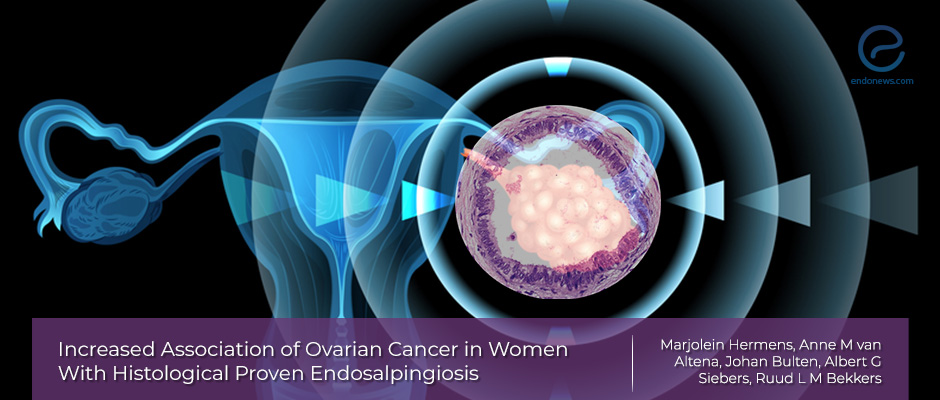The link between ovarian cancer and endosalpingiosis
Apr 17, 2020
There is an increased association between histologically diagnosed endosalpingiosis and ovarian cancer.
Key Points
Highlights:
- The presence of benign glands lined by tubal-type epithelium in the peritoneum and subperitoneal tissues is called "endosalpingiosis".
- The ovarian cancer risk for endosalpingiosis may be similar to that of other Mullerian tissues, based on the similarity of this association to the distribution of the ovarian cancer subtypes in endometriosis patients.
Importance:
- Pathologists should report "endosalpingiosis" accurately and gynecologists should be aware of the increased association of ovarian cancer in women with endosalpingiosis.
What’s done here?
- The possible association between endosalpingiosis and ovarian cancer was analyzed.
- The search of the database between 1990 and 2015 showed 2490 women with histologically proven endosalpingiosis; 1,005 (40.4%) had a concurrent histological diagnosis of endometriosis.
- The authors used 132,654 women with a benign dermal nevus as a control group.
- For women in both groups, histopathologic results for cancers of the ovaries, fallopian tubes, and peritoneum for the 27-year period were retrieved.
- The incidence rate ratio was calculated for ovarian cancer and its subtypes.
Key Points:
- In 2,490 patients with endosalpingiosis, age-adjusted increased incidence rate ratio (IRR) for ovarian cancer was found to be increased (43.7).
- Endosalpingiosis was detected to be more associated with clear cell and endometrioid ovarian cancer and less with serous ovarian cancer.
- When women with both endosalpingiosis and endometriosis diagnoses were excluded, the association with ovarian cancer remained increased (IRR=38.8).
- IRRs were found to be 2.4 and 1.8, respectively, when excluding synchronously diagnosed cases.
Limitations:
- This is a retrospective pathology-based database study; no clinical data is available on possible other risk factors, morbidities, or on survival status except for the presence of an autopsy.
- The tissue samples were not centrally reviewed, therefore inter- and intraobserver variability for the diagnosis of endosalpingiosis is possible.
- There might be an underreporting of endosalpingiosis cases since patients present without symptoms.
Lay Summary
The presence of benign glands lined by tubal-type epithelium in the peritoneum and subperitoneal tissues is called "endosalpingiosis". A recent study that investigates the possible association between endosalpingiosis and ovarian cancer was conducted by Hermens et al., from the Netherlands, and has been published in the journal Cancer Epidemiology.
In total, 2,490 women with histologically proven endosalpingiosis identified between January 1, 1990, and December 31, 2015, from the database were included in the study. Among them, 1,005 (40.4%) had a concurrent histological diagnosis of endometriosis. The control group consisted of 132,654 women with a benign dermal nevus. For women in both groups, histopathologic results for cancers of the ovaries, fallopian tubes, and peritoneum between January 1, 1990, and July 1, 2017, were detected.
The researchers found that the age-adjusted incidence rate ratio (IRR) (43.7) for ovarian cancer in patients with endosalpingiosis was increased. When compared to the control group, endosalpingiosis was detected to be more closely associated with clear cell and endometrioid ovarian cancer and less with serous ovarian cancer. When women with endometriosis diagnoses were excluded, the association with ovarian cancer remained increased (IRR=38.8) in the endosalpingiosis-only group. IRRs were found to be 2.4 and 1.8 respectively.
Since the researchers noticed that the association is similar to the distribution of the ovarian cancer subtypes in endometriosis patients, they suggested that the ovarian cancer risk in endosalpingiosis may be more like the risk in other Mullerian tissues. The authors drew attention to the possibility that the pathologist is more likely to report endosalpingiosis in suspected ovarian cancer.
This large cohort study showed an increased association between histologically diagnosed endosalpingiosis and ovarian cancer, even when women with histological endometriosis diagnosis are excluded. Therefore, pathologists should report endosalpingiosis accurately and gynecologists should be more aware of the increased association of ovarian cancer in women with endosalpingiosis. According to the authors, to estimate the risk of ovarian cancer more accurately, future research focusing on determining the true prevalence of endosalpingiosis will be essential. Risk factors of ovarian cancer in women with endosalpingiosis and the etiology of the association of ovarian cancer in endosalpingiosis patients should be further investigated.
Research Source: https://pubmed.ncbi.nlm.nih.gov/32146389
endosalpingiosis ovarian cancer increased association clear cell ovarian cancer endometrioid ovarian cancer

